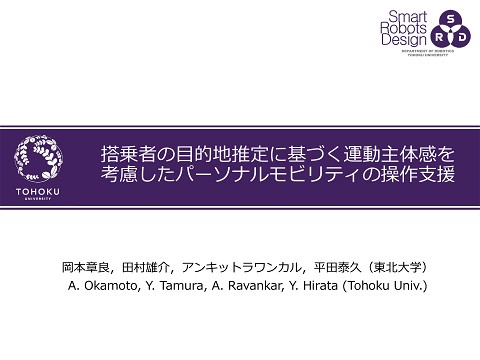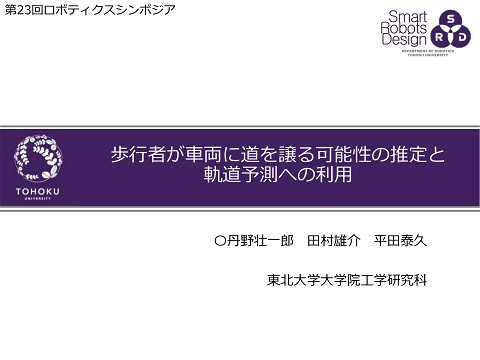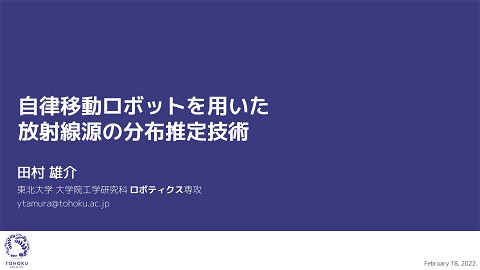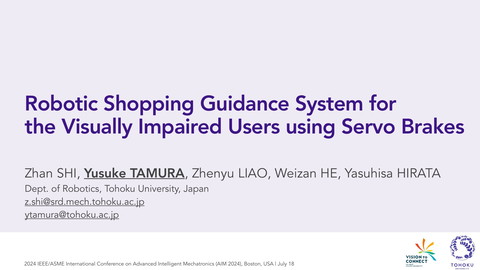Development of Pedestrian Behavior Model Taking Account of Intention (IROS2012)
338 Views
July 03, 23
スライド概要
Yusuke Tamura, Phuoc Dai Le, Kentarou Hitomi, Naiwala P. Chandrasiri, Takashi Bando, Atsushi Yamashita, Hajime Asama, "Development of Pedestrian Behavior Model Taking Account of Intention," Proceedings of the 2012 IEEE/RSJ International Conference on Intelligent Robots and Systems, pp.382-387, 2012.
東北大学大学院工学研究科ロボティクス専攻 田村研究室
関連スライド
各ページのテキスト
Development of Pedestrian Behavior Model Taking Account of Intention Yusuke Tamura1, Phuoc Dai Le2, Kentarou Hitomi3, Naiwala P. Chandrasiri3, Takashi Bando4, Atsushi Yamashita2, Hajime Asama2 1 Chuo University 2 The University of Tokyo 3 Toyota InfoTechnology Center, Co., Ltd. 4 DENSO Corp. 2012 IEEE/RSJ International Conference on Intelligent Robots and Systems, Vilamoura, Portugal, Oct. 8, 2012.
Motivation In human-‐robot coexisting environment... SAFETY is important. 2
Motivation In human-‐robot coexisting environment... SAFETY is important. Human is NOT a “moving obstacle.” 2
Motivation In human-‐robot coexisting environment... SAFETY is important. Human is NOT a “moving obstacle.” PREDICTION of human behaviors is necessary. 2
Related works and objective Pedestrian model... -‐ Social force model [Helbing 1995][Helbing 2000] 3
Related works and objective Pedestrian model... -‐ Social force model [Helbing 1995][Helbing 2000] Unnatural behavior 3
Related works and objective Pedestrian model... -‐ Social force model [Helbing 1995][Helbing 2000] Unnatural behavior Objective Pedestrian model: producing humanlike behaviors by considering pedestrian’s intention 3
Basic concept Create an appropriate subgoal according to the pedestrian’s attempted behavior. Behavior 4
Basic concept Create an appropriate subgoal according to the pedestrian’s attempted behavior. Behavior Subgoal creation 4
Basic concept Create an appropriate subgoal according to the pedestrian’s attempted behavior. Behavior Subgoal creation 4
Basic concept Create an appropriate subgoal according to the pedestrian’s attempted behavior. Behavior Subgoal creation 4
Basic concept Create an appropriate subgoal according to the pedestrian’s attempted behavior. Behavior Subgoal creation 4
Proposed pedestrian model 5
Proposed pedestrian model 5
Proposed pedestrian model 5
Proposed pedestrian model 5
Proposed pedestrian model 5
Intention transition & Behavior selection Intention Behavior Free Walk Avoid Follow 6
Intention transition & Behavior selection Intention Behavior Free Walk Avoid Follow 6
Intention transition & Behavior selection Intention Behavior Free Walk Avoid Follow 6
Intention transition & Behavior selection Intention Behavior Free Walk Avoid Follow 6
Intention: Free walk | Behavior: Free walk Behavior is based on the social force model [Helbing 1995]. Repulsive force from obstacles Repulsive force from Acceleration force towards Goal 7
Warning area Pedestrian 8
Warning area Pedestrian field of view 8
Warning area Pedestrian desired direction with ranges field of view 8
Warning area warning area Pedestrian desired direction with ranges field of view 8
Intention transition: Free walk }}} warning area Free walk 9
Intention transition: Free walk }}} Free walk 9
Intention transition: Free walk }}} Free walk Avoid or Follow 9
Intention transition: Free walk }}} Free walk Avoid Avoid or Follow Follow 9
Intention transition: Free walk }}} Free walk Avoid Avoid or Follow Follow 9
Intention transition: Free walk }}} Free walk Avoid Avoid or Follow Follow 9
Intention transition: Free walk }}} Free walk Avoid Avoid or Follow Follow 9
Intention: Follow | Behavior: Follow Repulsive force from obstacles Repulsive force from ( ) Acceleration force towards Subgoal 10
Frustration Frustration Following somebody intensifies the pedestrian’s frustration. Intention: Follow 11
Frustration Frustration Following somebody intensifies the pedestrian’s frustration. Intention: Follow 11
Frustration Frustration Following somebody intensifies the pedestrian’s frustration. Intention: Follow }}} Avoid 11
Frustration Frustration Following somebody intensifies the pedestrian’s frustration. Intention: Follow }}} Avoid 11
Intention: Avoid | Behavior: Avoid Repulsive force from obstacles Repulsive force from Acceleration force towards Subgoal or 12
Prediction for avoidance 13
Prediction for avoidance 13
Prediction for avoidance 13
Prediction for avoidance 13
Prediction for avoidance 13
Prediction for avoidance BAD subgoal 13
Prediction for avoidance BAD subgoal 13
Prediction for avoidance BAD subgoal 13
Prediction for avoidance BAD subgoal GOOD subgoal SELECTED 13
Prediction for avoidance BAD subgoal GOOD subgoal SELECTED If both candidates are good, will select the nearer subgoal. 13
Prediction for avoidance BAD subgoal GOOD subgoal SELECTED If both candidates are good, will select the nearer subgoal. If both candidates are bad, will be forced to follow. 13
Experiments Comparison between simulated and observed pedestrian behaviors. Participants: 6 healthy volunteers (5 men, 1 woman; 23-‐29yrs.) : participant (walk to G) : cooperator (walk to R or C or L) (1) Scenario: (2) 1: walks to G while passing who walks straight in opposite direction. 2: walks in a hurried pace to G, and walks with normal speed to R or (3) C or L. 3: walks in a hurried pace to G, and walks with normal speed to R or C or L. L R L R 14
Observation and Simulation Observation Measurement: 2 LRFs (UTM-‐30LX; Hokuyo Automatic, Co., Ltd.) Height: 0.87m Frame rate: 10fps Num. of trials: 6 participant x 9 trials (3 times x 3 goals of ) for each scenario Simulation Environment: Input: Mac OSX 10.6.8 C++ / OpenGL Environmental information, observed cooperator ’s trajectory Output: Trajectory of the simulated agent 15
Comparison between simulation and observation (e.g.) Scenario 3 ( walked to C) 16
Comparison between simulation and observation (e.g.) Scenario 3 ( walked to C) 16
Results Comparison between the proposed model and social force model Trajectory Error (m) 2.0 1.5 ** ** ** 1.0 0.5 ** p<0.01 0 (a) Scenario 1 (b) Scenario 2 (c) Scenario 3 paired t-‐test 17
Conclusion Pedestrian behavior model considering pedestrian’s intention. -‐ Subgoal creation based on the intention transition -‐ Behavior selection based on the prediction Proposed pedestrian model can produce more humanlike behaviors than the social force model. Future works -‐ A Large number of pedestrians -‐ Online parameter estimation 18
20
Free walk }}} If no other pedestrian in the warning area free walk If other pedestrian β penetrates the warning area ... If the traveling directions of α and β are roughly opposite ... avoid If their speed difference is low or α moves slower than β ... follow If α moves much faster than β ... avoid 21
Intention: Avoid | Behavior: Follow Repulsive force from obstacles Repulsive force from Acceleration force towards Subgoal 22
Parameter identification 8 parameters were determined based on observation experiments. Participants: 6 healthy volunteers (5 men, 1 woman; 23-‐29yrs.) Measurement: 2 LRFs UTM-‐30LX (Hokuyo Automatic, Co., Ltd.) Height: 0.87m Frame rate: 10fps Obstacle & Robot: ZEN (Ritecs, Inc.) Size: 0.45 x 0.45 x 0.75 m (a) Desired speed 6 times for each condition. (b) Warning area / Subgoal for avoidance 6 times for each obstacle position v=0.3 or 0.5 or 0.8 m/s (c) Subgoal for follow 3 times for each combination of the robot’s start position and speed 23
Parameter identification 8 parameters were determined based on observation experiments. A B C D E F (m/s) 1.4 1.3 1.2 1.5 1.5 1.2 (m/s) 2.2 1.9 2.0 2.0 2.3 1.7 (m) 8.9 8.8 8.9 9.0 9.0 9.1 (m) 1.04 1.26 0.73 0.86 0.58 0.84 (m) 0.26 -‐0.98 0.37 -‐0.08 1.60 -‐0.34 (m) 2.1 2.5 1.5 1.7 1.2 1.7 (m) 2.1 2.3 2.0 2.4 1.5 2.1 (m) 1.0 1.2 1.0 1.2 0.76 1.0 24





